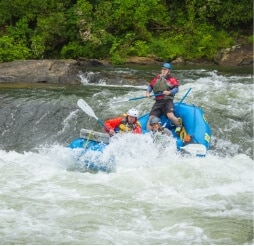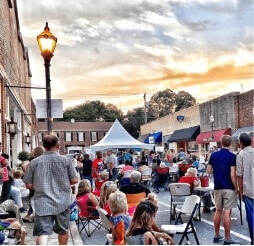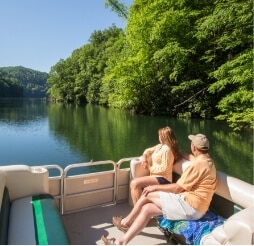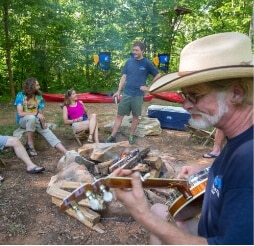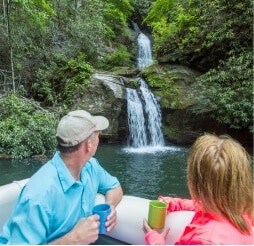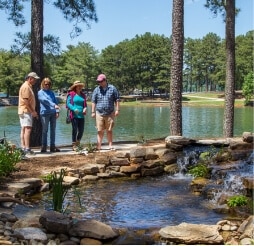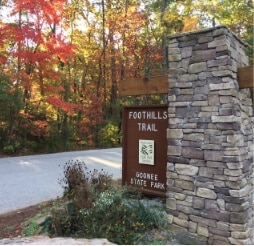Bad Creek is a hydroelectric power station owned by Duke Energy.
The staff and board members of Visit Oconee SC were invited to tour this facility that few people get to see.
Here’s a look behind the scenes:
The lay of the land
The name Bad Creek came from the Cherokees. Sometimes they’d find water in the creek–and sometimes not– so they called it a “bad creek”.
The Dam
Two dams make up Bad Creek. The main dam and a much smaller west dam. We were able to drive on the main dam and got out to look around.
Lake Jocassee is below the dam. Sometimes residents on Lake Jocassee and Lake Keowee chime in on social media that the lake levels are really low. But in fact, lower levels are normal and means the pump storage system is working properly.
They are required to re-survey the dam every year and compare it year over year to determine if it’s shifting or moving. They monitor seepage at base of dam too and submit a dam survey report to FERC every year.
Bad Creek Reservoir
A lake was constructed above the pump station to serve as an intake for moving water back and forth as conditions warrant. This comes into play if Duke is going into an outage period at one of its facilities. The plant was designed so that zero water enters the facility when maintenance is required. Bad Creek Hydro Station has four turbine units (400 mega watts each) to move water back and forth between the Bad Creek Reservoir and Lake Jocassee. The reservoir is not a recreational lake.
Creeks and tributaries fill the lake reservoir and keep it full. Duke can draw down the water level of the reservoir to 160 feet. The middle of the reservoir is 400 feet deep. The rock quarry is the deepest point. There’s an intake on the bottom of the lake that’s like a “bathtub drain” that drops 800 feet straight down. Fish retreat into rock quarry when the lake is drawn down but there’s a federal restriction so no fishing is allowed on the reservoir.
The Lake System
Water leaves Bad Creek Reservoir and flows into Lake Jocassee then from Jocassee it flows into Lake Keowee. From Lake Keowee water flows into Lake Hartwell. When water is in Lake Hartwell, it’s no longer available to Duke Energy. The water is property of the Corps of Engineers at that point.
The Bad Creek Project
Known as the “Bad Creek Project”, this hydroelectric station is one of Duke Energy’s newer hydropower plants. The site for this pumped-storage facility had to meet very specific criteria and required enough geographical height and water availability. Construction of the facility took nearly 10 years and was completed in 1991. The Bad Creek Hydro Station produces enough energy to power nearly 1,000,000 homes!
The powerhouse is 600 feet inside the mountain. The station generates electricity by moving water between an upper and lower reservoir. The upper Bad Creek Reservoir formed when Bad Creek and West Bad Creek were dammed. Lake Jocassee is the lower reservoir. The hydro pump station produces electricity during periods of peak demand. When demand is high, water is released from Bad Creek Reservoir down to pump turbines that operate as generators to produce electricity. Once electricity is produced, the water is returned back to Lake Jocassee. This type of system is useful to balance base loads at power plants and allows for additional power during times of peak demand.
Licensing
In 1977 FERC (Federal Energy Regulatory Commission) granted Duke Energy a 50-year license to operate. Bad Creek Pumped Storage Project is FERC Project no. 2740. Duke has started preparing a new license application to continue operating Bad Creek and has proposed expanding the project to include a Bad Creek II Power Complex. Learn more here.
Update: May 2024
Over the course of five years, the units in the powerhouse were revamped and upgraded to add 80 additional megawatts per unit. All the units were disassembled. The pump turbine and generator were replaced with new components that have modern technology. A fourth unit was added to the facility. The facility’s combined capacity is 1,680 megawatts.
Lake App
An app called “Duke Energy Lake View” is available for download. It’s possible to get information about all the lakes operated by Duke Energy. You can view lake levels for the Keowee-Toxaway basin, which includes Lake Jocassee and Lake Keowee. The app has features including Access Alerts to see which sites are expected to be closed for various reasons.
Recreation Access
The area surrounding the Bad Creek Project is totally protected–meaning access is restricted and no development is allowed.
Part of the license agreement to operate the Bad Creek pump-storage facility requires Duke Energy to provide recreational access on land adjacent to the hydro station.
For that reason, Duke maintains 44 miles of the 77-mile Foothills Trail. This trail is well known and popular for extended hiking trips, backpacking, camping and day-use.
Duke also allows access to Musterground Road for recreation usage. This area is sought after by hunters and 4-wheel recreational vehicles. The terrain is very rough and rugged–which is what 4-wheel RV enthusiasts love! Musterground Road is open only during hunting season, it is NOT OPEN year round.
It’s difficult to understand South Carolina’s hunting regulations! This page explains Wildlife Management Areas (which Musterground is considered). Oconee County is split into two WMA Zones: Game Zone 1 and Game Zone 2. According to an article posted on Hiking the Appalachians and Beyond, Musterground Road should be open all of April (spring hunting season) and September 15 through the end of December (fall hunting season). Check the South Carolina Hunting website for exact hunting season dates.
- Tags: Discover Oconee
-
Post Author: Ken Sloan



